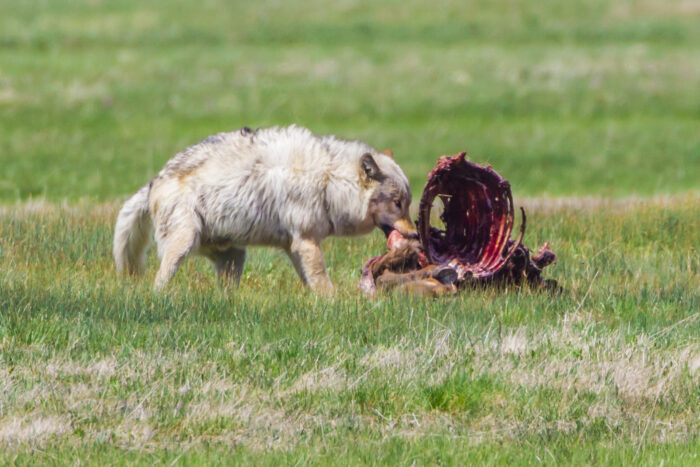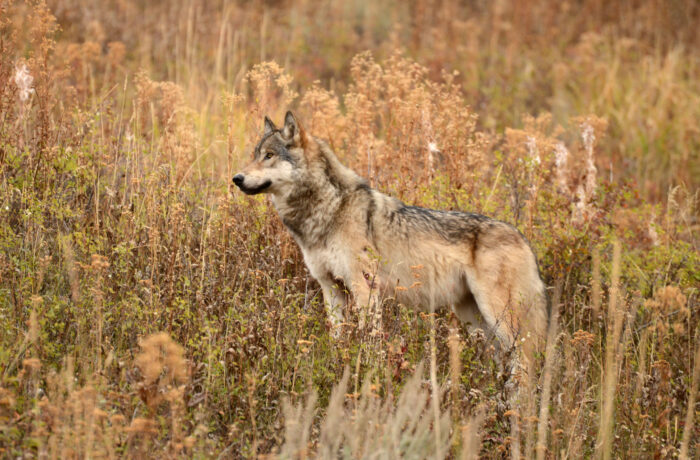The voters spoke in 2020. Now the wolves are coming home to the Colorado high country. And with them, they are bringing a firestorm of controversy.
It’s been more than 70 years since humans killed off the last wolves from Colorado’s landscapes. But unless a lawsuit is successful, state officials will begin re-establishing the population as soon as Monday, Dec. 18. That’s because Colorado voters decided by a very narrow margin to mandate the reintroduction. Thus, Colorado Parks and Wildlife (CPW) must restore and manage the wolf population as an “essential part of the wild habitat.”
CPW must also mitigate conflict between the predators and ranchers as well as consider economic and social factors related to restoration. And this is where things are starting to get messy.
While many residents, ranchers, and recreationists are concerned about the reintroduction of the gray wolf, perhaps the next most concerned group is big-game hunters. Big game in Colorado is already struggling after one of the harshest winters in years. CPW reduced limited deer, elk, pronghorn, moose, and bear tags by 12% and shortened the 2023 season in the hope of boosting populations. Survival rates for the 2022-2023 winter were “below what CPW previously thought possible in elk,” the agency wrote.
Though the survival rate for mule deer was higher, the combination of winter conditions and CWD has affected the population. The most affected groups lie in the northwest corner of the state, just north of where CPW plans to release the first 10-15 wolves.
Plenty of Elk Still on the Landscape

Wolf reintroduction adds another variable of adversity for ungulate populations, as the new wolves will rely on prey like deer, elk, and moose. CPW says they aren’t concerned about the effect wolves may have on ungulates, at least not yet.
“Despite the short-term impacts to elk within the severe winter zone, northwest Colorado’s elk herd remains the largest in the state with sufficient numbers of ungulates to provide for a large population of wolves,” Travis Duncan, CPW’s public information supervisor, wrote in an email to GearJunkie. Duncan said CPW doesn’t expect the reintroduction of wolves to have “widespread impacts” on ungulate hunting in the state. However, it’s “impossible to predict.”
Colorado maintains the country’s largest elk herd at over 300,000, with a sizable portion of that number in the northwest.
Matt Barnes, a rangeland scientist and researcher who was on the CPW Stakeholder Advisory Group for the reintroduction, argues that the northwest portion of the state is some of the best habitat in the country for elk — making it a good wolf habitat as well.
“Basically, any place that has great elk habitat is probably going to be good wolf habitat unless there’s too many people,” he said. “Western Colorado is a phenomenal elk habitat — the best elk habitat in the country. And if it were only elk that made wolf habitat, Colorado could probably have a few thousand wolves, and we do have more than that number of black bears and mountain lions already.”
Making Room for Wolves

Various studies have indicated that the state could support anywhere from 400 wolves to over 1,000 based on prey abundance, human population growth, and road development. Currently, CPW has identified between 10 and 20 wolves, including pups, in the past five years. These are believed to have migrated from the Greater Yellowstone Area.
In Barnes’ eyes, it’s still an open question as to how many wolves the state can realistically support, but the habitat is “probably better than Wyoming and about as good as Montana,” he said. The biggest challenge for the state’s wolf reintroduction will be mitigating conflict with ranchers and livestock and how CPW addresses the conflict.
That means discouraging wolves from preying on livestock and directing them toward wild ungulate populations. CPW will pay up to $15,000 per confirmed wolf depredation incident. Though that money won’t come from hunting or fishing licenses, it does come from the state’s general fund and is powered by income and sales taxes.
The Rocky Mountain Elk Federation (RMEF) posed a list of issues the organization had with Proposition 114 when it was on the ballot. These included the potential costs to Colorado taxpayers to cover wolf management tasks and livestock compensation payments from the state to ranchers. RMEF declined to comment on this story.
Wyoming’s Wolves, 28 Years Later

Looking north to the state of Wyoming, the estimated amount of wolves is now well above 300, and one-third to one-half of the wolf packs have conflicted with livestock, according to the Wyoming Gray Wolf Monitoring and Management 2022 Annual Report. The state paid $187,382 in livestock compensation for 97 head of livestock in 2022, confirmed to have been killed by wolves. It paid much more in years prior.
Wyoming is now in its 21st consecutive year of maintaining a wolf population above recovery criteria established by the U.S. Fish and Wildlife Service, though the state uses lethal means to manage the population. According to CPW, there is no such plan for Colorado. Wyoming started with 41 wolves in 1996.
Wyoming’s wolf management program also allows for the lethal take of wolves when unacceptable impacts to ungulates or feed grounds are suspected. The Wyoming Game and Fish Department did not conduct any lethal removal actions as a result of unacceptable impacts to ungulates or elk feed grounds caused by wolves.
Barnes has compiled his own data in the Northern Rocky Mountain states of Idaho, Wyoming, and Montana on the effects wolves have had on ungulate populations. His findings are similar in that hunter harvest of elks has been unimpacted in the three states.
“There are some identifiable trends,” wrote Barnes. “The Northern Rocky Mountain elk population collectively has increased since wolf reintroduction.”
He adds, “Elk harvest has followed a similar pattern to elk populations: a significant increase in Montana, moderate increase in Wyoming, and parallels the elk populations in Idaho. Hunter’s success rates have fluctuated from year to year but, over time, have stayed similar. Wyoming has significantly higher hunter success rates than Idaho or Montana (or Colorado).”
Wolves May Be the Least of Elk Herds’ Problems

Aside from the occasionally devastating winter, elk herds in Colorado face a host of adversities. Droughts, human population growth, fencing, competition for habitat with livestock, recreational trails, and residential development all play a part.
These factors have all lowered calf recruitment, and CPW’s outlook doesn’t add much optimism.
“Ultimately, these impacts and ongoing habitat loss will reduce Colorado’s carrying capacity for the renowned elk population we presently support,” notes the 2022 Draft Elk Herd Management Plans for the Southwest Region.
CPW also noted that cow-calf ratios have been on the decline since the 1980s. At that time, there were about 60 calves per 100 cows. Today, the number is closer to 35-40 calves per 100 cows, a number that may not be sustainable over the next 20 years.
Barnes agrees with CPW’s assessment of the biggest threats that elk herds in Colorado are up against. In fact, newly introduced wolves will share those challenges with elk. Habitat loss and fragmentation, recreational development and pressure, conflict with agricultural interests, and development on public and private lands will have impacts regardless of species.
“The mortality to wolves and other predators is just so small compared to everything else that affects elk populations; it just hasn’t mattered,” Barnes said.








